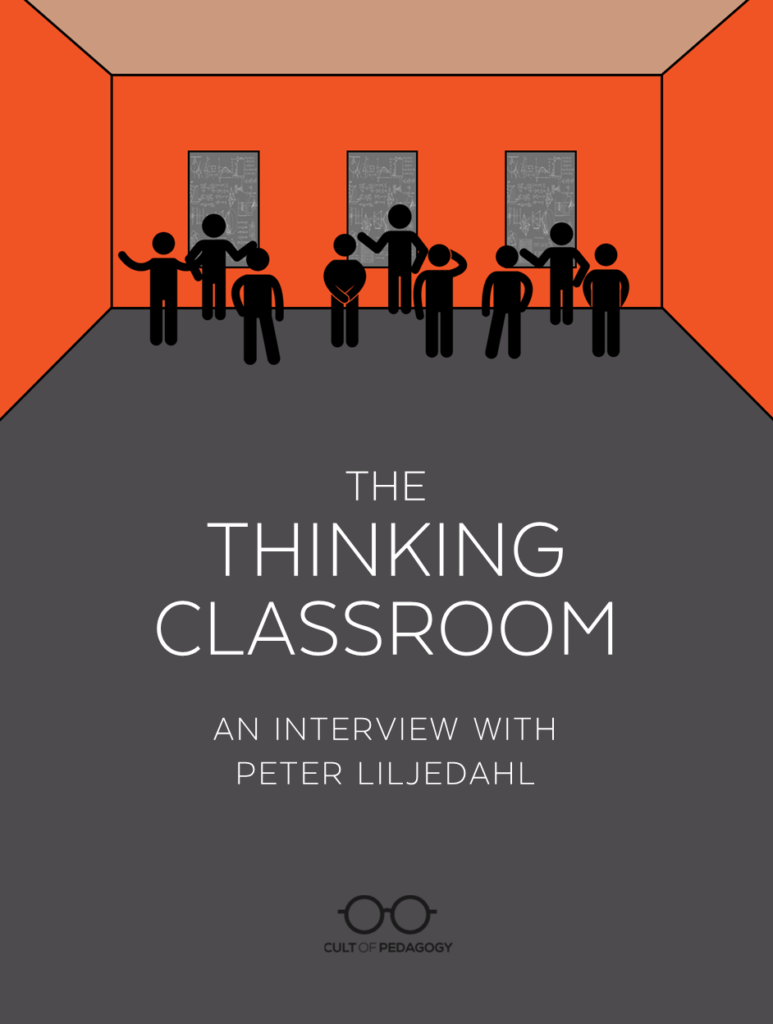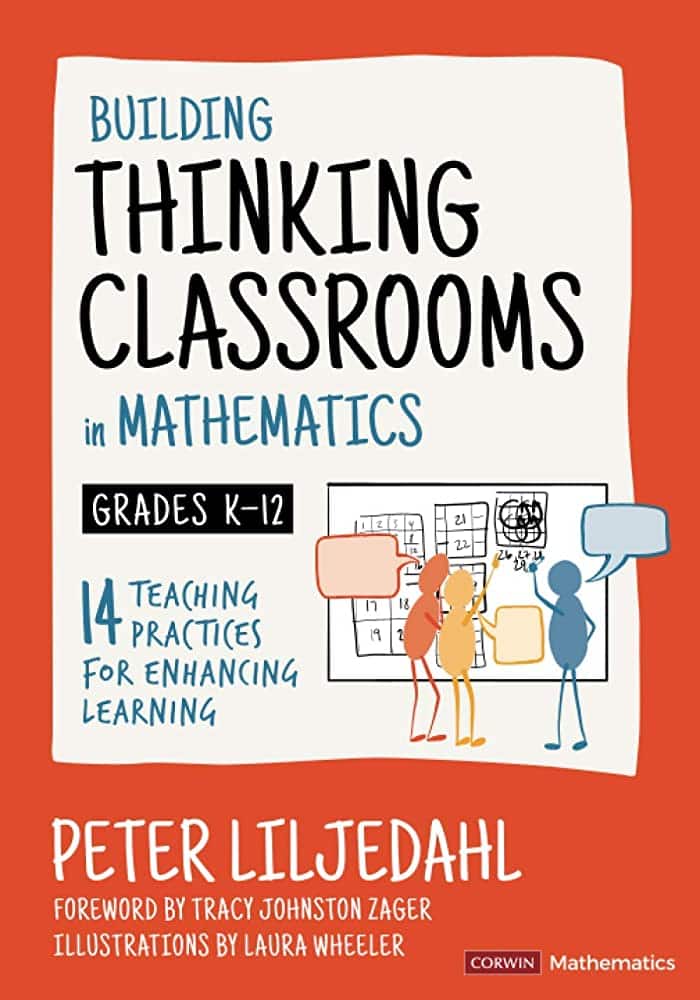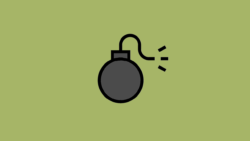
Listen to my interview with Peter Liljedahl (transcript):
Sponsored by Listenwise and Wipebook
This page contains Bookshop.org links. When you make a purchase through these links, Cult of Pedagogy gets a small percentage of the sale at no extra cost to you. What’s the difference between Amazon and Bookshop.org?
This post was supposed to be just for math teachers. I was going to share an instructional approach that, as dramatic as this sounds, has taken the math world by storm. The methodology is called Thinking Classrooms, and now that I have gotten a closer look at it, I can see that it could work in just about any content area. Built on 14 key practices, it’s a way of teaching that gets students up on their feet, collaborating and thinking through challenging problems on a daily basis.
When I first saw a video of this strategy in action, I was immediately captivated. Take a look:
The more I learn about the Thinking Classrooms method, the better it gets. Thousands of math teachers are already using this approach, and it’s spreading to other subject areas as well.
Joining me to talk about this on the podcast is Peter Liljedahl, professor of mathematics education at Simon Fraser University in Vancouver, British Columbia, the creator of the Thinking Classrooms method, and the author of the book, Building Thinking Classrooms in Mathematics, Grades K-12: 14 Teaching Practices for Enhancing Learning. In our interview, which you can listen to above, Liljedahl talked with me in depth about the Thinking Classroom. Some key points are summarized below.
How Thinking Classrooms Got Started
Liljedahl began to formulate his approach after spending hours observing in dozens of different math classrooms. What he saw was not surprising: classroom after classroom of students who were not engaged and not actively learning.
“By and large students spend most of their class time not thinking, at least not in ways we know they need to think in order to be successful in mathematics.” Liljedahl explains. “If they’re not thinking, they’re not learning. And everywhere I go classrooms look more alike than they look different: Teaching and learning in math classrooms adheres to a set of normative structures that date back to the dawn of public education over 170 years ago. We’re going to have to break through some of these normative structures because they are actually creating environments that are not conducive to thinking.”
What followed was a 15-year process figuring out how to break down these institutionally normative structures that were, as Liljedahl puts it, “holding non-thinking in place.” Breaking those norms down means putting in place other practices that have now become foundational to the Thinking Classrooms approach.

The Practices
A Thinking Classroom is built on 14 practices, many of which were developed by looking at what was already happening in typical classroom, doing the exact opposite, and seeing what happened. Some of the key practices are summarized below.
Thinking Tasks
Unlike in a more traditional classroom, where the lesson might start with direct instruction from the teacher, a typical day in a Thinking Classroom starts with the teacher assigning thinking tasks for students to work on in groups, and direct instruction is only given on an as-needed basis.
“In a traditional classroom,” he explains, “we show the students how to do it, then we do one together, then they practice it on their own, the classic I do, we do, you do, which promotes — whether you want it or not — a form of behavior called mimicking. So these students are just going to mimic their way through. In a Thinking Classroom, in order to get students to think rather than mimic, we have to remove the I do.”
When they are first introducing this approach, teachers are advised to make the thinking tasks non-curricular, fun challenges that will help develop a culture of thinking. Once students are used to the format, the tasks become curriculum-based, often the same kinds of problems you’d find in the resources you’d normally use, but Liljedahl points out that they are carefully sequenced, “very carefully constructed,” he says, “whereby the tasks are getting incrementally more challenging and are being given to students as their abilities are incrementally developing.”
Vertical, Non-permanent Surfaces
Probably the most distinctive feature of a Thinking Classroom is the use of vertical, non-permanent surfaces, where students do the tasks, standing up, in groups of three.
Why vertical? “When it goes vertical, everyone has the same orientation to the work,” Liljedahl explains. “When it’s vertical, they can see each other’s work, which promotes knowledge mobility and gives greater access to more ideas. When it’s vertical, I can see everything. I don’t have to wait for that quiz next Friday to see if the students understood it. I can see right now, and then I can intervene right now. I can’t do that if they’re horizontal.”
But there’s one more benefit of vertical surfaces that Liljedahl learned from interviewing students, one reason he felt eclipsed all the others. “It turns out that when students are sitting, they feel anonymous. And the further they sit from the teacher, the more anonymous they feel. And when students feel anonymous, they disengage. What standing up did was took away their anonymity. It made students not feel invisible, and then they didn’t disengage.”
The other important feature of these surfaces is that they are non-permanent. Unlike paper, which can’t be reused, an erasable surface like a whiteboard or chalkboard turns out to be more conducive to thinking tasks. Liljedahl and his colleagues found this out through experimentation.
“If we compared a group working on a whiteboard versus a group working on flip chart paper,” he says, “the group working on the whiteboards, they’ll start within 20 seconds. They’ll start making notations on the board. They’ll try anything and everything because they feel like they can just erase it if it’s wrong. The students who are tasked with working on flip chart paper, they will not make a single notation for upwards of three minutes, because ‘This is not erasable. What I put here has to be perfect.’ So there’s a lot of agonizing, and that hesitation leads to a lower form of thinking.”
Visibly Random Groups
Students collaborate on tasks in randomly assigned groups of three, and that randomization has to be visible. Liljedahl explains why on the Building Thinking Classrooms website:
“Whether we grouped students strategically or we let students form their own groups, we found that 80% of students entered these groups with the mindset that, within this group, their job is not to think. However, when we frequently formed visibly random groups, within six weeks, 100% of students entered their groups with the mindset that they were not only going to think, but that they were going to contribute. In addition, the use of frequent and visibly random groupings was shown to break down social barriers within the room, increase knowledge mobility, reduce stress, and increase enthusiasm for mathematics.”
Another important feature is that each group only gets one writing instrument; this forces members to collaborate, rather than work in parallel.
Consolidation Practices
Once students have worked through the assigned tasks at the boards, they transition into what Liljedahl calls consolidation, activities that reinforce each individual student’s learning.
“It turns out that there’s a difference between what we call collective knowing and doing and individual knowing and doing. Working collectively at the whiteboards and working individually are actually very different modalities; there needs to be some sort of a transfer.”
The consolidation practices that facilitate that transfer are:
- guided gallery walks, where the teacher points out key elements of student work on the vertical surfaces
- note making, where students construct their own meaningful notes: “They take their learning from the day and find a way to represent that in such a way that they can in part have a record, but more importantly go through that process of reification, where they are taking these ideas that started very informal and unstructured, became more formal and structured through the consolidation and now become even more formal and structured through their note making activity.”
- check your understanding questions, a form of self-assessment students do on their own to determine how well they have grasped the material
How to Get Started
The book (linked above) is a great place for math teachers to start, but if you’re not a math teacher, that shouldn’t stop you. “These practices are being enacted in every curriculum now,” Liljedahl says. “Language arts, social studies, science. There are slight variances to it, but fundamentally what changes is what constitutes a thinking task, which is Chapter 1 of the book, and what constitutes a sequence of thinking tasks, which is Chapter 9. Everything else more or less stays the same.”
Interested teachers should also join any one of the online communities of teachers who are already running Thinking Classrooms of their own. The largest is the Building Thinking Classrooms Facebook group, but Liljedahl says there are many others.
“Try it,” he says. “The book gives you plenty of resources and ways to enact it in a way that’s almost guaranteed to have some early success so that you can see for yourself what this looks like. I always say that my book has stories and data in it, but those are my stories and my data. The real data, the real stories that are going to impact your practice, that are going to sustain your practice, are the story and the data that happen in your own classroom, right. Give it a try. See what happens.”
Join our mailing list and get weekly tips, tools, and inspiration that will make your teaching more effective and fun. You’ll get access to our members-only library of free downloads, including 20 Ways to Cut Your Grading Time in Half, the e-booklet that has helped thousands of teachers save time on grading. Over 50,000 teachers have already joined—come on in.






I watched the video and read your post on the Thinking Classroom. I really like that idea, and I’m trying to see how to apply it to 11th grade English. I can see how it could be used with practicing sentence structures, punctuation, diagramming, or even composing with vocabulary….
But I’m wondering about using it to teach reading. I’m about to head into Modernism; The Great Gatsby; structure; connotations and tone; development of multiple themes; POV and perspective… Do you have any ideas for how to use Thinking Classroom strategies with reading?
Larissa, it’s so exciting to hear that you’re considering applying this model to your English classroom! As Peter mentions near the end of the podcast episode, there are quite a few online communities that have emerged. If you search Facebook groups for “Building Thinking Classrooms” you will find several different groups of educators that might be able to provide ideas and support. Also, as more people read and interact with this post, there will likely be some great ideas right here in the comments!
I am a middle school ELA teacher and want to start using these practices to foster a building thinking classroom! I hope to see ELA tasks and practices applied by others so I can see it modeled. These ideas will fit well with my Modern Classroom Project teaching! YAY!
Laura, this sounds incredible! We hope you’ll come back and let us know how it goes.
I also use the MCP model (modified somewhat!) in my 8th grade English classes–and I was thinking that this would fit in well. I’m just struggling to imagine what it will look like. I’m excited to see what new ideas emerge as we work toward it! Are you in the Facebook group?
Hi Lizz, I am just now learning about this approach AND I am getting ready to start my Modern Classrooms Project in early April! I also teach 8th grade ELA and am very interested in applying DTC to my classroom. However, I have been looking on Facebook and on search engines to try to find some more teachers with similar grades and subjects and I haven’t had any luck. If you are interested in collaborating at all, please reach out! Maybe you, Laura and I could start a group to bounce ideas around in. 🙂
Hi Laura, I am just now learning about this approach AND I am getting ready to start my Modern Classrooms Project in early April! I also teach middle school ELA and am very interested in applying DTC to my classroom. However, I have been looking on Facebook and on search engines to try to find some more teachers with similar grades and subjects and I haven’t had any luck. If you are interested in collaborating at all, please reach out!
Hey Laura, Lizz, and Stacy!
I teach middle school ELA too! I teach 7th grade gifted and advanced medium- sized humans. I am also an MCP educator and advocate. I would love to collaborate with all of you. I am interested in learning more about how to turn my classroom into a solid space for thinking.
I also am an MCP teacher in 10th grade ELA! I am going to try to use these strategies as my whole group activity before we move into self paced work. I’d love to know how it has been working for you.
I am LOVING reading about this approach. I am currently in my masters program and I am seeking out modified classrooms and approaches. This will be one that I will for sure share with my peers. My one question would be, do you find it difficult to form a summative assessment for students. What about those students that are shy and find it hard to interact?
Hey, Lizz. I’m beginning to learn about this methodology as I prepare to begin my Modern Classrooms Project in early. I am also a teacher who is very interested in incorporating Controller into my classroom. However, I have been searching on Fb and digital platforms for more teachers with similar grades and subjects and have had no luck. Please contact me if you are interested in collaborating in any way! Sometimes just you, Laura, and I could form a brainstorming group.
I teach an adult ESL Advanced Vocabulary class and have a classroom where the walls are whiteboards floor to ceiling. I used this idea this week to review vocabulary. There were 2 sets of 5 tasks posted around the room. Students moved around in small groups, wherever they needed to go to do each task, whenever they were ready. So nice! The 5 tasks had the vocabulary list & directions. 1. Write a fill-in-the blank with enough context that the answer is clear, 2. Write a situation followed by a short sentence with a target word. (ex. They talked for days and days and still don’t have an answer. The talks are ongoing.) 3. Write a discussion question. 4. Fix the repetition in the sentence (only task where I wrote 10 sentences – ex: The artist drew beautiful drawings for the book.) 5. Write a short tongue twister. The ability to erase, ask for help, move around, read other’s answers, discuss, disagree, collaborate, & revisit to see what had been added made it a hit. At the end, I took pictures and posted for students, but we will use their tongue twisters & discussion questions in the next class. Just sharing for those out there doing vocabulary. I think the trick for language is thinking of tasks that can be done in any order & have a variety of possible output.
Thanks for sharing, Rachel. It’s great to hear that these strategies are being used in adult education, too.
Great ideas, but I got stuck on the “students stand and write on vertical, non-permanent surfaces.” My classroom has limited space and bringing in portable whiteboards was not an option (no space, no money). On a Saturday morning when I didn’t want to be on campus catching up on work, I noticed the cleaning crew discarding our PPE plastic boards. Your idea met my idea. The PPE plastic is the vertical surface, whiteboard contact paper is the non-permanent surface. To store the boards, the “feet” pop off and the boards can lay flat. Ready, set, learn!
Wow! Teachers are so creative. Thanks for sharing!
Very informative. Great idea.
I am very interested in Peter Liljedahl’s work within mathematics courses. Students in my classroom have been struggling in the past few years with critical thinking and problem-solving skills. Peter’s suggestions for creating a classroom that encourages critical thinking, making mistakes, and learning through the process is exactly what my students need to strengthen the skills they are lacking.
I am instructional coach and I have a teacher that is beginning to use thinking tasks in her 5th grade classroom. She and her students are loving them. She has done an amazing job implementing and her students’ engagement has increased drastically. My question is about differentiation. If students are working in randomized groups, how do you ensure that your students are able to access or extend the concepts?
There are two ways to think about differentiation – the planning we do to provide different tasks to different students and the in-the-moment differentiated instruction we do during a lesson. BTC does the second as teachers can so easily see which groups need support.